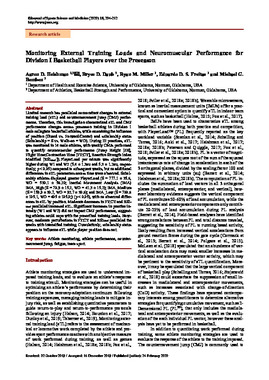| dc.contributor.author | Heishman, Aaron D. | |
| dc.contributor.author | Daub, Bryce C. | |
| dc.contributor.author | Miller, Ryan M. | |
| dc.contributor.author | Freitas, Eduardo D. S. | |
| dc.contributor.author | Bemben, Michael G. | |
| dc.date.accessioned | 2020-10-09T14:17:17Z | |
| dc.date.available | 2020-10-09T14:17:17Z | |
| dc.date.issued | 2020-02-24 | |
| dc.identifier.citation | Heishman, Aaron D et al. “Monitoring External Training Loads and Neuromuscular Performance for Division I Basketball Players over the Preseason.” Journal of sports science & medicine vol. 19,1 204-212. 24 Feb. 2020 | en_US |
| dc.identifier.uri | https://hdl.handle.net/11244/325589 | |
| dc.description.abstract | Limited research has paralleled concomitant changes in external training load (eTL) and countermovement jump (CMJ) performance. Therefore, this investigation characterized eTL and CMJ performance changes across preseason training in Division 1 male collegiate basketball athletes, while examining the influence of position (Guard vs. Forward/Center) and scholarship status (Scholarship = S vs. Walk-on = WO). During 22 practices, eTL was monitored in 14 male athletes, with weekly CMJs performed to quantify neuromuscular performance (Jump Height [JH], Flight Time:Contraction Time [FT:CT], Reactive Strength Index Modified [RSIMod ]). PlayerLoad per minute was significantly higher during W1 and W2 (5.4 ± 1.3au and 5.3 ± 1.2au, respectively; p < 0.05) compared to subsequent weeks, but no additional differences in eTL parameters across time were observed. Scholarship athletes displayed greater PlayerLoad (S = 777.1 ± 35.6, WO = 530.1 ± 56.20; Inertial Movement Analysis (IMA) IMA_High (S = 70.9 ± 15.2, WO = 41.3 ± 15.2); IMA_Medium (S = 159.9 ± 30.7, WO = 92.7 ± 30.6); and IMA_Low (S = 700.6 ± 105.1, WO = 405 ± 105.0;) (p < 0.05), with no observed differences in eTL by position. Moderate decreases in FT:CT and RSIMod paralleled increased eTL. Significant increases in practice intensity (W1 and W2) did not impact CMJ performance, suggesting athletes could cope with the prescribed training loads. However, moderate perturbations in FT:CT and RSIMod paralleled the weeks with intensified training. Cumulatively, scholarship status appears to influence eTL while player position does not. | en_US |
| dc.description.sponsorship | The authors would like to thank Mr. Brady Brown and Mr. Keldon Peak for their assistance with this project. Additionally, the authors thank the Basketball Programs at the University of Oklahoma for their continued support of research directed at enhancing athlete performance, while also improving overall student-athlete welfare. Finally, the authors would also like to thank all of the student-athletes that graciously volunteered their time to enroll and participate in this study. The experiments comply with the current laws of the country in which they were performed. The authors have no conflict of interest to declare.
Open Access fees paid for in whole or in part by the University of Oklahoma Libraries. | en_US |
| dc.language | en_US | en_US |
| dc.subject | Athlete monitoring | en_US |
| dc.subject | Athlete performance | en_US |
| dc.subject | Countermovement jump | en_US |
| dc.subject | Fatigue | en_US |
| dc.subject | Team sport | en_US |
| dc.title | Monitoring External Training Loads and Neuromuscular Performance for Division I Basketball Players over the Preseason | en_US |
| dc.type | Article | en_US |
| dc.description.peerreview | Yes | en_US |
| ou.group | College of Arts and Sciences::Department of Health and Exercise Science | en_US |

